The NuVinci (later renamed Enviolo) continuously variable transmission for bicycles
The original version (ca. 2008) is a great hub (even though it is heavy), but for me the shifting is too slow and it's hard to change gear at low speed while pedalling with force. In the newer N360 these issues have been taken care of (mostly).
2021-8-28: Addition: The Nuvinci hubs have been renamed to Enviolo in 2017.
Specifications (of the loose hub):
Mass: ca. 3693 g
Size: width: 135mm over-locknut dimension, diameter: 159 mm.
Dimensions for spoke calculation: For Sapim spoke calculation page: K=135, Ka=39, Kb=40, D1 gear=147.5, D1 non-gear=147.5
[ K=hub width, Ka=distance of flange to hub-end, Kb=same, D1 gear=diameter of circle through the spoke holes on the gear side, D1 non-gear=diameter of circle through the spoke holes on the non-gear side ]
Price: ca. €400,- (complete with shifters etc.)
Pictures:



|
Tested bicycle: Batavus Sc2, 61 cm (a little too large for me, which gives me rather too stretched out position as I really like a short top tube or forward seatposts such as an old Speedliner triathlon seatpost. This Batavus bike is very nice to look at, see the pictures. Mass is ca. 16,5 kg. I also weighed my trusty Koga-Miyata World traveller from 1992, which came to ca. 18.5 kg including panniers from Hema.
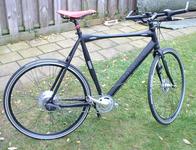
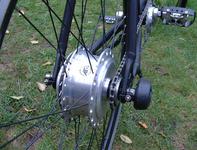
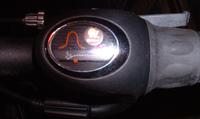
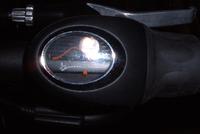
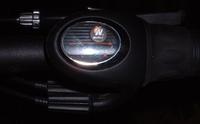
The twist shifter has an interesting way to indicate the gears, namely with a variable height hill. Hill = small gear to go up a hill (or of course to accelerate), flat = large gear to go fast on flat terrain.
1. First impression on a short ride: A very interesting feeling, along with the realization that bad gear changes are impossible, so there's no rattling noise when the derailleur doesn't precisely change the gear to the wanted cog (which you must solve by going up an extra gear, then back down again, or vice versa, etc.). That was precisely what had been bothering me the week before. Due to cold and wet conditions my 3x7 speed Shimano system (on an old but in perfect condition being Koga-Miyata World traveller) didn't work very well. Some low gears I couldn't reach at all. At the time I thought I might need to oil the shifter again, but in turned out to be mainly the derailleur which was stuck from all the grime. Shifting was slow, the chain often hung on a cog and rattled before going to the next one. I may also need to oil the cables again.
With the NuVinci you may also need to lubricate cables again from time to time of course. On the test bike the cables are completely covered with full length outer cable, which improves things a lot w.r.t. weatherproofing. But even if through say cold, something would change in cable length (perhaps disproportionate shrinking of the inner and outer cable? Unlikely though as both are made from steel. More likely is stretching of the inner cable over time, and lubricants not lubricating very well at low temperatures which can exacerbate the stretching), this just means that the chosen gear as indicated by a certain position of the twist shifter selects a slightly different gear than before. It wouldn't mean the entire gear shifting won't work properly any more as with a derailleur!
I further noticed during that first brief ride, that the twist shifter/hub needs quite some force to change gear. This isn't much different from other hubs with twist shifter, but I would like to see a very light going gear change system.
The twist shifter needs to be turned quite a bit for the entire range (1.25 revolutions) (*). I also think a Nexus 8 also needs to be turned quite a long way btw. This means you're quite busy turning the shifter, when you're accelerating after a traffic lamp. Therefore I'm not as quick to accelerate with this hub as with for example the thumb/index finger levers with 3x7 speed derailleur on the Koga WT. Using my Campagnolo Chorus 10 speed equipped road bike which can change several gears up/down at a time, I can accelerate quicker, and I was also faster with my old Koga-Miyata Terraliner Carbolite 3x7 speed derailleur system with bar end shifters which also allows you to switch several gears up/down in one go. A Nexus 8 speed hub isn't any better than the NuVinci, so you should compare it to that hub.
(*) In one movement you can turn your wrist about 90 degrees, so this means to get from the lowest gear to the highest, you must turn your wrist, let go and move your hand back in the original position 4 times, then again turn 90 degrees. This is too much, and it is too slow...
2. The first longer ride (10 km): Quite a lot of headwind/side wind and it was pretty cold (around the freezing point). I rode at constant speed on a bit of road shielded by trees and houses, atfer which followed a section without trees with a lot of wind from the side. I made a slight change to the gear and continued with the same pedalling frequency (cadence). That works pretty well, much better than most derailleur systems, at least if they have largish differences between cogs (such as 12-14-16-18... teeth on the cassette), but it's not better than a 10 speed road bike (with 11-12-13-14-15 etc. on the cassette). A perfectly tuned 10 speed road bike with e.g. Campagnolo Chorus shifts just as smoothly, you hardly feel that the chain goes to another cog and the steps in gearing are so small that it sometimes seems as if you haven't shifted at all...
I cycled the same route back again a few hours later, with quite a bit of tail wind. That was enough to try the higher gears and it showed the gear range is sufficient for use in NL, which has few hills and no mountains.
Speed considerations: Do you lose speed compared to other gear systems? Well, slightly but it's normally not noticeable. See 'Efficiency' further down the page.
In other reviews on the net I read that some people are continuously turning the shifter to adjust the gear. This is not something I do. I don't change gear unless I there's a need, e.g. when I cycle on a road where it's more open than before (wind from the side), or the reverse, or with hills (bridges) and of course at traffic lamps. I don't think I'm fiddling with the gears more than on the Koga WT (3x7 speed derailleur).
3. Another 20 odd kilometre cycled with lots of wind and cold: I will go into more detail about the heavy going twist shifter: When you're not applying (much) force, it's ok, and especially in mid to high gears there isn't a problem changing gears no matter how hard you pedal. In fact, there isn't much difference in how hard/easy the gear changes are whether you pedal or not. The case when you really notice it, is in low gears, such as when you're accelerating after a traffic lamp. When you switch back to a very low gear, it is hard (i.e. force required to turn the shifter is high) to get the hub into a high gear while applying force on the pedals. You will briefly need to pedal less hard and shift up during that time. This, together with the long travel of the shifter required, makes accelerating nowhere near as fast as with a derailleur system. For most cyclists this is probably not a big deal, I think.
When you're riding faster, the hub changes gear quickly and easily, so you can briefly lower the gear for for example a small bridge or even a longish speed bump, then immediately back again. That doesn't work with a derailleur unless it's perfectly set up/lubricated (otherwise: rattling, extra gear/up/down to get the chain right etc., or it may just take so long to change gear you already passed the bump)
4. Another ride of 20 km at slightly higher temperatures and a little bit of wind: Everything I noticed in the earlier rides is still accurate, I don't think much can be added. For me there remain 2 disadvantages to this hub:
- I don't really like twist shifters.
- Accelerating from a traffic lamp is not as fast as with a derailleur because it's hard to get the hub in higher gear when you're in low gear and pedalling hard. Also, you need to turn the shifter quite a bit.
5. A woman's perspective
I had my sister try the bike as well, and she rode it on a couple of rides, testing the gear changes when accelerating, when going up/down a hill, etc. Her conclusion: Perfect hub, better than the Nexus 8 speed! She didn't think the twist shifter was heavy going. Perhaps I just need to get used to such a shifter, as I had never used a twist shifter for a long period... (just briefly the Nexus 8 speed, from time to time).
Btw., from what I heard, most women who try this hub prefer it to other hubs...
Conclusion:
- The extra mass of the hub compared to other geared hubs (nearly 4 kg versus nearly 2 kg) is something you don't notice during normal use.
- The continuous character of the hub has advantages when you're cruising and get side wind when you get to a bit of open terrain for example. You can then easily/quickly/securely adjust the 'gear' a little. Not finding the right gear is something you will never have. With most other hubs you will in some gears get a feeling of 'I want a different gear!' which occurs because of the sometimes rather big jumps in gearing with some hubs; in particular between gears 5 and 6 of the Nexus 8speed (or Alfine). After noticing that and upon checking the documentation found that that is indeed the biggest jump in gears in those hubs.
- No clicking in the hub when changing gear.
- There are no adjustment problems (that cause poor gear changes). If the adjustment does change (wear/stretch to gear cables), this won't affect the gear selection, just that the indicated gear on the shifter may be slightly different to the actual gear (well: you won't be able to reach the maximum/minium gear but that seems insignificant to me).
- Changing to higher gear when you're accelerating in low gear is difficult. With some regular gear hubs (but really in particular an Nexus or Alfine with rapidfire levers; a twist shifter is a lot slower, similar to the NuVinci) or derailleur, one can accelerate quicker. This is only a disadvantage if you like to accelerate very quickly, as I do... Once you're cruising at say 15 km/h or more, changing gears is easy and smooth and turning the shifter is as easy as e.g. a Shimano Nexus 8 speed hub.
Specifications (of the loose hub):
Mass: ca. 2529g (bare hub)
Size: width: 135mm over-locknut dimension, diameter: ca. 138 mm.
Dimensions for spoke calculation: For Sapim spoke calculation page: K=135 mm (hub width), Ka=40 mm (distance of flange to hub-end), Kb=40 mm (ditto) , D1 gear=125 mm (diameter of circle through the spoke holes), D1 non-gear=125 mm
[ K=hub width, Ka=distance of flange to hub-end, Kb=same, D1 gear=diameter of circle through the spoke holes on the gear side, D1 non-gear=diameter of circle through the spoke holes on the non-gear side ]
Price: ca. €400,- (complete with shifters etc.)
Pictures:
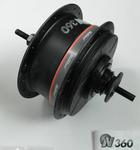
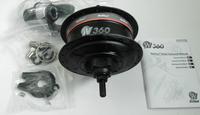
Comparison of the size of the original N171 and the newer N360:
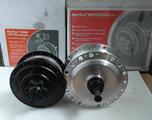
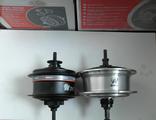
|
Experiences
Tested since: 19 May 2012 (in progress)
Though I had a wheel spoked in and ready to go since mid August 2011, I had too much testing of bicycle lighting equipment to do first and there were other circumstances that delayed testing. Test finally in May 2012 after rebuilding my bikes for testing lots of stuff.



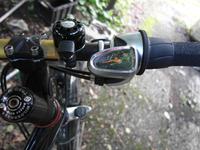
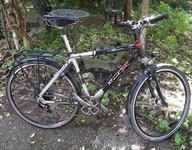
The loose hub comes without outer shifting cables, and the rear sprocket is also sold separately from the kit, so take note of that! Setting the hub so that you get the entire reach of gears is some work, but doable. The main thing is absorb the text from the manual and understand what they mean to say in it, and why some things need to be done as they are shown in the manual when installing the shifter. This could be explained more clearly though you could just mindlessly follow the steps, but I'm not like that, I wonder "why?" about everything :)
Building the hub into a wheel was pretty easy due to the symmetric flange size/distance to axle left and right.
Before riding I thought I might have to manually set the hub into overdrive as per the manual despite taking care not to shift the hub while fiddling with installing the sprocket, etc., because I could only get a limited gear range. However, this is apparently normal. You can only switch gears for about a tird of a turn which is about a quarter of the range (you feel the shifter abrubtly hitting a wall) until the hub starts rotating.
The chain is an issue. As the shifter-hub-interface mechanism is now within the frame, it doesn't leave very much room for the chain and thus Fallbrook have chosen to allow only 3/32 chains (7 and 8 speed chains, but there are 3/32 narrow single speed chains for internal gear hubs such as the Connex 7R8, 700 etc.), not the narrower 11/128 9 speed chains (they don't fit over the Nuvinci sprocket), and 1/8 single speed chains are too wide (they contact the shifter-hub-interface).
A connex 100 single speed has chain pin length of ca. 9.40mm.
So at first I tried with a Wipperman Connex 7R8 which is quite wide for a narrow chain: pin length: 8.80mm. This is a bit too wide, I can hear the chain contacting a part of the shifter-hub-interface. See the following picture:
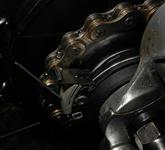
Then a Connex 700: Pin length = 7.85mm
I think Fallbrook should have made the hub's mechanism/sprocket placement, such that a single speed chain can be used. This is one of the attractions to a geared hub: Not having to replace the 7-8-9 speed chains every 2000km or so (no 7-8-9 speed chain I ever used lasted longer than 2000km (Shimano, Wipperman, KMC)).
In use: To test the limited shifter range during stand still and how that affects the situation where it can be an issue, I pedalled in maximum gear, then stopped, shifted to lowest gear I could get to and started riding. It was not great but doable, and shifting under pressure is no problem at low speed contrary to the old Nuvinci, so you can quickly switch to a still lower gear.
Now that I'm seriously using this hub there is one thing I don't like: The shifter rotation is forward to shift down, and I would prefer forward = higher gear for going faster. This makes more sense to me though perhaps physiologically this way is better. I didn't pay much attention to this aspect in the N171 but I will do some tests and perhaps I will change my mind about this :) I could just swap cables but then it means the hill on the shifter means a high gear (and not a gear for a hill). Actually, that could make sense: Hill = hard work, and cycling in a high gear is also hard work ;-).
Btw.: With a Nexus 8 speed hub on a different bike (I assume it's the same with the Alfine and Nexus 7) the shifter shifts as with the Nuvinci: forward rotation = smaller gear.
To be done: Gear ratio: I'm using the hub with a triple in front but only with the 48 and a 20 tooth sprocket in the rear. Tests with a 36 in front to be done. Gear range comparisons with other hubs to follow.
2012-5-27: I noticed something I don't like:
A few days ago I noticed in use what I thought was just the shifter. Before running the hub in my bike, by just twisting the shifter, I felt a notchiness in the shifter. Something similar I experience while riding, and I'm sure it's to overcome the fairly high static friction, so each gear shift (up in particular) gives actually a jump in gear change because of the force required (so you overshoot little gear changes). It seems the switching force has been reduced quite a bit w.r.t. dynamic friction, but the static friction hasn't been reduced as much or at all. This gives jumpy gear changes which isn't a problem but reduces its value over hubs that use normal gears, and the smooth gear increase/decrease as is possible on the N171 on the Batavus testbike (esp. the quick gear up/down when going over a tiny hill, or the up/down slope of a small bridge) is not possible. Increasing the cable tension might improve things. I will see if this improves it.
2012-5-27: I also noticed something weird:
Yesterday I noticed that the hubs shifts into a lower gear automatically, i.e. the shifter changes its position after a while. The shifter has recesses in it to provide more grip I suppose, and if I put the shifter such that one is on top, after ca. 3 minutes riding the next one is on top. I checked this after I felt something was wrong with the gears when riding the same gear on long straights: Pedalling seemed to become easier after a while. It wasn't due to what I imagined could be a problem: If the hub is not tightened enough wit the nuts, there could be some movement despite the no-turn washers and then repeatedly switching between pedalling and coasting might cause shifter changes.
But no, it seems the 7R8 chain was to blame. It runs just slightly against the shifter-interface from time to time and this moves it into a lower gear!
Test with the Connex 700 (7.85mm width of chain pins): Problem remains... Perhaps I need to bend the clip outward a bit? I could grind off a bit of that metal clip... I suppose I should try an even narrower chain?
The shifter has a bolt to set the shifter tightness, and this is said to be to reduce unwanted feedback. With this do they mean the shifter rotating by itself from 'feedback' from the hub? If so the hub has a tendency to go into a lower gear by itself. I will test this...
2012-7-7: Shifter performance in the rain
It gets quite slippy, and this is another problem with twist shifters: You need grip! With push (and pull) shifters almost no grip is required as the force you apply is almost perpendicular to the lever's surface.
The first problem of a rotating shifter is that the entire hand needs to move to shift, instead of just the thumb and index finger with push/pull levers. This is the main reason I don't like twist shifters and also makes shifting slower than with moving a small lever.
2012-11-5: Conclusion after a lot of use
With a narrower chain (ca. 7.00 - 7.10 mm width of the chain pins) I didn't have the problem any more of the gear automatically changing, but future hubs should be changed so that a wide single speed chain can be used. Why didn't they just move the plastic gear changer on the hub 5mm further outward? With the gear-change gone, I like the hub. The gear range could be a bit bigger but with a ratio of 36/20 which is the lowest allowed and with which steep hills can be climbed, it's still possible to ride up to about 42 km/h in the highest gear. That is enough unless you want to ride races in which you want to get the maximum out of a tail wind and descents. I still don't really like the rotating shifter, as I don't like rotating shifters in any system. A lever is quicker and has other advantages such as described above. There is an automatic gear shifter for the NuVinci N360 (Harmony) where you set the desired cadence and the system changes gears for you. This is apparently possible with standard bicycles too, using an extra battery. I will look into this.
2013-2-26: Shifter-hub interface
I noticed that there is a newer version, perhaps that doesn't have the problem of touching wider chains? (which causes the automatic change in gear ratio)
Conclusion
The range is a little limited, but if you really want more, that can be fixed by using a double or triple chainring. I want to test the Alfine 11 which has the advantage of having a press-shifter available, and that is the only real competition I can see. The Shimano Nexus/Alfine 7 and 8 speed hubs, Sturmey Archer 8 speed and the SRAM i-Motion 9 speed don't appeal much to me because of fiddly settings (Sturmey), or strange gear ratio jumps (Shimano) or because it only comes with a twist shifter and the i-Motion has longevity issues and it is no longer made since mid 2011. I read that SRAM may introduce a new 8 speed hub... The Nuvinci 360 seems the nicest of the hubs I tried, though I would really like a different shifter. The Rohloff speedhub I don't include in my contemplations due to the price and what it's designed for. And I didn't ride with one for long enough yet. It also doesn't have a press-shifter although some other makers now provide this, or wanted to provide this. When I checked in March 2013 I still saw nothing in production... Anyway, I will put it stronger than before: Rotary gear shifting sucks!
Originally this section was part of the review of the N171 hub, but it's also valid for the N360:
I read that Fallbrook doesn't really talk about the hub's efficiency, and some people therefore think the efficiency is low. Suppose the it is 0.85 x, compared to say 0.95 x of a system with Alfine hub, and 0.97 x of a derailleur system, All with a clean chain, and fairly straight chain line (I chose the value of 0.85 x due the achieved range of electric cars that have been equipped with Alfine and NuVinci hubs as gearboxes; it also lies in the range that one would expect). That would mean a loss of a factor of 1.11 in power compared to an Alfine hub, which leads to a decrease in speed, which largely depends on air resistance (required power is linear with the third power of the speed), of about 1.0 km/h at 30 km/h. So, instead of 30.0 km/h you would ride 29.0 km/h (and with a derailleur you would ride ca. 30.3 km/h). That's not a large difference. It's calculated of course, not measured, but considering the weather that changed when I tested this bike (cold + wind) and the too-stretched out position on the test bike which meant I wasn't going at it full speed, and couldn't properly compare with previous bike rides on the Koga WT (3x7 speed derailleur), I have to take this calculation as an estimate and I think it's close to the real value. I certainly didn't have the feeling that the bike has more resistance because of this Nuvinci hub. One aspect of efficiency is that optimal cycling happens at certain pedalling frequencies. So, part of the loss of the hub can be gained compared to other geared hubs, but how much can be gained I'm not sure of: Proper testing of efficiencies would require a biomechanical measurement of cyclists at different cadences going at the same speed on the NuVinci and other hubs would be needed. Separate measurements (biomechanical efficiency at different cadences at various power levels but also the efficiency of the NuVinci using an electric motor as input) would be interesting.
- http://hubstripping.wordpress.com/ (but not much news the last few years and I miss a good comparison of in particular the Sturmey 8 speed and the Nuvinci with other hubs)
Last modified: 2021-8-28

















